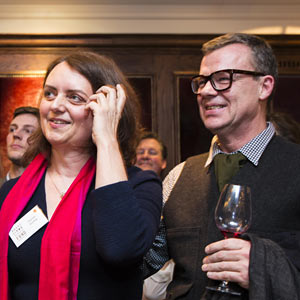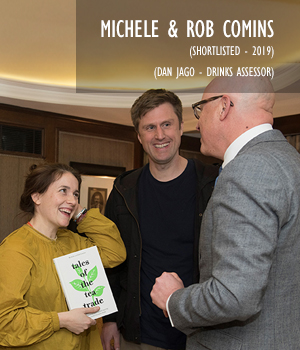Jeremy Lee: A cook and his books
"Judging the André Simon Award is a life enhancing experience. My respect for writers, editors, publishers and all the crafts required to bring a book to life soared. A great book can often be a friend for life, inspiring, a work you can return to often for reassurance and a buck u uppo. The distinguished list of books that reached the long list for The André Simon Award, the short list and finally the runners up and finally, the winner are all wonderful voices on their subjects, clear and authoritative. It is a source of great joy to be cherished." My parents liked to read, cook and eat, quite liked their brood and made efforts to have us all at the table every day. In the kitchen, a small pile of cookery books (pulled from laden shelves), with a pad and a pencil for notes, awaited my mother's interest.
My parents liked to read, cook and eat, quite liked their brood and made efforts to have us all at the table every day. In the kitchen, a small pile of cookery books (pulled from laden shelves), with a pad and a pencil for notes, awaited my mother's interest.
To this day this is how I love to read a book: at home, surrounded by piles of this, that and the other. I sometimes find my finger, as my mother's did, tap-tap-tapping at a recipe on a page.
While my mother was very much a modern woman, she also had respect for that which had come before. This applied as much to cookery books as anything else. She admired those who kept the home fires of British food burning: Marian McNeill, who had scoured Scotland and written down many old recipes in the 20s. In the 30s came Florence White's Good Things in England, who championed British food and collected many, often eccentric recipes dating as far back as the 14th century. Another was Hilda Leyell who authored The Gentle Art of Cooking and started Culpepper's herb shop chain in London. I remember shopping at the tiny original shop, sadly closed, in Bruton Street, for orange and grapefruit oils. Later on, Jane Grigson's books did much to bring food to the fore in Britain.
Something changed in the nation's appetites after the second world war, both for food and what was written about it. Elizabeth David's first book, Mediterranean Food, published in 1950, switched the nation on to simple, good cooking from warmer climates. War and rationing were grim memories; writers in this period wanted sunshine and cheer, not the clipped tones of Mrs Beeton or Constance Spry. And what revelations! They opened eyes to the French and Italian regions, beyond capital cities, where markets reflected the seasons and good ingredients cooked simply were the greatest prize. If you grew up in a remote part of the country, as I did, outside Dundee, those books were almighty.
A whole new generation of restaurants was opening, run and staffed by folk who devoured cookery books like thrillers
I came to London to be a chef in the 70s, when being a chef had little allure. The food world was still starched and traditional: high hats, an implacable kitchen hierarchy and Escoffier was God. I worked through those years with my nose stuck in a book between shifts; the same books that had inspired my mother became constant companions, giving colour to lacklustre produce and stainless steel professional kitchens. As interest in food gathered momentum, I worked with some extraordinary cooks: Simon Hopkinson and Alastair Little. We all shared a love of travel, good food and great writing - Elizabeth David was our high priestess.
So, in us, the likes of David had a following, but they didn't get the wider attention they deserved until, perhaps, the 80s. At this point, great changes began in food, produce and restaurants; books began to appear with more frequency on every kind of cooking imaginable. As walls were being pulled down and boundaries blurred and as the classics lost their grip, restaurateurs started speaking of menus inspired by Elizabeth David. She, Jane Grigson and Julia Child were uttered by the lips of even staunch French chefs. A whole new generation of restaurants was opening, run and staffed by folk who devoured cookery books like thrillers. These books, written decades before, suddenly became, quite literally, the plat du jour.
From the Davids, the Grigsons and the Childs, another generation of women food writers blossomed, restoring an interest in regional cooking to an English-speaking readership. Alice Waters championed the local, seasonal movement in California and influenced future generations of American cooks, and many more besides around the globe. Arabella Boxer, who was an early champion of British and seasonal cooking, helped tear up the rigours of publishing with her extraordinary two-volume set of First Slice Your Cookbook, then, A Second Slice. Caroline Conran's beautiful editing of four seminal chefs, Michel Guérard, Roger Vergé and Jean and Pierre Troisgros, finally loosened the tired grip of France's haute cuisine. Lindsey Bareham's books have a glorious approach, championing the potato, the onion, soup or tomatoes in a clear authoritative voice full of wit, charm and warmth.
These distinguished writers, among others, brought a brightness to local, seasonal cooking helping hugely to bring British cooking to the fore. I remember when Carol Field wrote a book on Italian baking that kindled a return of good bread and bakers from a sad decline. Paula Wolfert's writing on Morocco and Claudia Roden on Middle Eastern cooking brought forth delight in the cooking of the Mediterranean with great charm. Marcella Hazan lit up both sides of the Atlantic with her Classic Italian cookbooks and blew every cliché of Italian cooking to smithereens. Elisabeth Luard acknowledged that real cooking had its roots in peasant food, writing in her seminal books European Peasant Cookery and European Festival Cookery.
The huge rise in interest in food in recent years has books appearing with such speed that keeping up with the new is in itself a great occupation. Photography changed the production of books dramatically. Now a book illustrated with a couple of ink drawings and the occasional frontispiece may well seem challenging beside a lavishly photographed volume. It is worth pausing to consider whether reading a recipe alongside a glorious colour photograph depicting the dish might diminish the imagination slightly? Subsequently possibly the writing is diminished too.
There is one curious result to these leaps and bounds of progress: the potential to move so far ahead that one loses sight of what went before. For sure, some of these books are of their time and of interest to only a few. But it is worth, now and again, just sitting at a table, in a rare quiet moment, looking once more at a book, even without photographs, which might have inspired the mother of a cook to tap-tap-tap at a recipe and set to in the kitchen.
Jeremy Lee's favourite five
1. Elizabeth David
Her writing has the ability to make you pick up a pencil and start putting together a meal. She inspired me and many of those I've worked with over the years, and that inspiration has never diminished. Here are some dishes I have enjoyed from French Provincial Cooking, Summer Cooking and An Omelette and a Glass of Wine: grillade des mariniÈres du Rhône, tarte aux pommes à la Normande, and St Emilion au chocolat.
2. Jane Grigson
A pioneer who helped kindle the flame that restored seasonal and regional cookery to the Britain. Grigson's learned storytelling is woven in among recipes that were, even then, rare and with ingredients quite scarce, such as bloaters and buckling (types of smoked herring). They make for delightful reading in bed as well as at the table. Try Good Things, The Fruit Book, The Vegetable Book. I am a particular fan of her walnut tart - the lighter, more elegant cousin of pecan pie.
3. F Marian McNeill
Born in Orkney, this estimable woman wrote beautifully on the lore and cooking of Scotland. Had these books not been written, much might not have seen the light of day, such as cabbie claw, a soup of cod cooked in horseradish and parsley, and served with an egg sauce. Try The Scots Kitchen or The Scots Cellar for barley broth, hotch potch (mutton stew with vegetables) and nettle soup.
4. Florence White
You will be so immersed in reading Good Things in England that it will be bedtime before you even think to put the kettle on. Recipes were gleaned from all over Britain and made practical. I like the salmagundi, an amazing salad incorporating fruit, vegetables, meat and fish, and was a favourite in the Renaissance court. Her soups made with spinach and celery are great, too.
5. Eliza Acton
The woman who pioneered the modern cookbook, able to distil much that had been written before and make it simple and delightful. Try Modern Cookery for Private Families, which is full of advice and comfort in abundance. Her recipe for oxtail soup begins: "An inexpensive and very nutritious soup may be made of oxtails, but it will be insipid in flavour without the addition of a little ham, knuckle of bacon, or a pound or two of other meat." Her writing style makes for effortless page-turning.
Jeremy Lee is the chef-proprietor of Quo Vadis restaurant in London @jeremyleeqv
Reproduced with kind permission of Guardian Cook.


The Trustess of the fund are:
Nicholas Lander - Chairman
Sarah Jane Evans MW
David Gleave MW
Xanthe Clay
Food Assessor
Lennie Ware
Drink Assessor
Dawn Davies
Secretary To The Fund
Katie Lander
E: katie@andresimon.co.uk
Press and PR
Press and PR for the awards is handled by tpr media consultants.
Sophie Toumazis
T: 020 8347 7020
E: sophie@tpr-media.com
